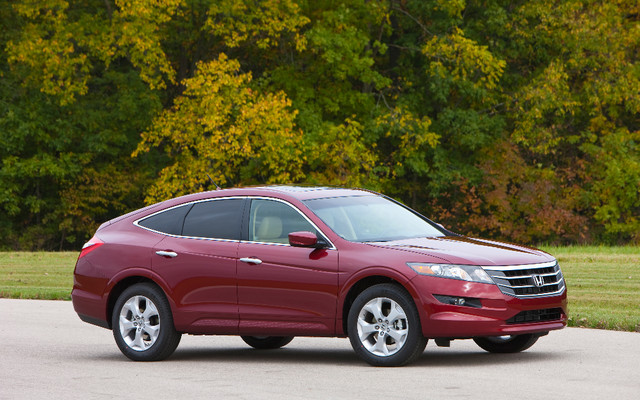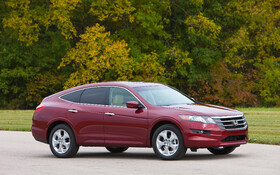2010 Honda Accord Crosstour: An interesting mutation

| Strong points |
|
|---|---|
| Weak points |
|
In an understandable desire to sell as many vehicles as possible while controlling costs, Honda has decided to offer a Honda Accord hatchback. This technique is decades old and, when applied properly, can be very lucrative. In the case of this Accord with an inflated back end, the transformation was pulled off quite well!
For several years, the Honda/Acura duo has carved out a niche in nebulous marketing. For example, Honda launched the Accord Crosstour at almost the same time that Acura launched the ZDX. These two vehicles are almost the same size, with similar architecture and lines. And yet, they’re two entirely different vehicles. The good news is that for every loser, there’s a winner!
Some obvious differences, at least
While the ZDX is built on the Acura MDX platform, the Accord Crosstour gets the chassis of the… Accord! However, the engineers had to adjust the rear suspension so that the vehicle could come with, on option, the CR-V’s 4WD. In addition to the aesthetically different rear end, the front is also different from the Accord Coupe. The grille, for example, is much less imposing on the Crosstour.
Inside the vehicle, all is much the same as before, other than a few minor details in the presentation. The instrumentation may not be original, but it is easy to read. At night, the gauges are very pretty, but the windshield gets too much reflection from the central screen (which includes the GPS and onboard computer) – even in night mode. Plus, the headlights are very strong. The dashboard on this vehicle, like all Honda/Acura products, features a plethora of buttons, which are not always easy to figure out, especially at first. Some of these buttons have the difficult task of operating the audio system. In fact, I would even say that the only merit of this system is that its buttons are pretty. Luckily, there are several storage cubbies in the dash. Visibility out front is good, but toward the back is another story altogether. Wide pillars on the sides and the horizonal bar that runs across the tailgate obstruct the view, a little like the Insight and the ZDX!
The front seats are comfortable, but they don’t offer much support on tight turns. Accessing the back seats is easy, and there’s plenty of headroom, provided you’re not taller than 5’9" (judging by the height of my son, who is 5’6"). The two main rear seats are pretty soft, even springy, while the centre spot is alright for occasional use.
As the vehicle’s lines would suggest, the Crosstour’s trunk is somewhat bigger than that of the sedan, and definitely bigger than the coupe’s. The coupe offers 338 litres, the sedan has 397, and the Crosstour has between 728 and 1453. Although those numbers may seem high when compared to the sedan or the coupe, the Fit, which is a lot smaller, can pack between 585 and 1622 litres. In other words, you don’t buy an Accord Crosstour for purely practical reasons! The trunk floor is reversible. It’s carpeted on one side, and covered in an easy-to-clean hard plastic on the other. Under the floor is a sizeable cargo space. Spare tires, however, can be stored under the vehicle.
Mechanics that speak
Shopping for an Accord Crosstour is not exactly rocket science, since just one version is offered in Canada: the EX-L. Some options are available, the most interesting of which is the Real Time 4WD, which is also available on the CR-V. As for engines, the Honda comes with the same 3.5-litre V6 found in other models, such as the Odyssey. Developing 271 hp and 254 lbs-ft of torque, it can push the 4WD Crosstour from 0-100 km/hr in 8.3 seconds, which is not bad, but not mind-blowing. In comparison, an Accord V6 sedan (with FWD) does the same trick in just 6.6 seconds. The extra 200 kg that the 4WD packs on is definitely responsible for part of this difference, considering their transmissions have the same number of speeds.
This 3.5-litre offers Variable Cylinder Management (VCM) which deactivates a row of cylinders when they are not needed. Apparently, this can help you save up to 10% on gas, but forgive me if I’m skeptical. What’s more, shifting from this mode to regular mode was really noticeable on our test vehicle. Doing a consistent 100 km/hr on the highway, I got the impression that the flow of gas to the injectors was not always regular, which could become downright annoying over time. However, on other Accords with the same engine, this transition was imperceptible. Weird...
During our week-long test drive, the Crosstour maintained an average consumption of 9.9 L/100 km, which is far from breaking any records, especially for a Honda. Keep in mind, though, that this vehicle weighs 1845 kg (4,067 lbs.). Plus, the fact that it runs on regular gas is a point in its favour.
Just one transmission is offered. It’s an automatic five-speed that works well enough. That said, it would have been interesting if Honda had paired the Crosstour’s engine with the Accord Coupe’s six-speed gearbox. As for the 4WD, its duty is to give the vehicle better traction in snow and slush, and help it negotiate the corners of the Nurbürgring! You just need to drive this vehicle for a few minutes on a rough road (not hard to find in much of Canada) to realize that the suspension was designed more for comfort than for road handling. The Accord Crosstour gets good marks for handling, but not for sportiness. There’s some roll on tight turns, but nothing extreme. During normal driving, the steering is fairly precise, but it loses its bearings during more aggressive driving. This might explain the Crosstour’s rather low towing capacity: 680 km (1,500 lbs.).
$$$$
In using the regular Accord to create the Crosstour, Honda could not go wrong. Plus, giving it 4WD without adding too much to the price sweetened the pot even more. The price of the basic Crosstour hovers around $34,900, which seems a little pricey to me. The 4WD version costs $36,900, is safer in the winter and will have a better resale value down the road. The GPS version costs $38,900, but this accessory is not Honda’s forte (a good ol’ Garmin or TomTom – which are much less expensive – would do the job just as well). The Crosstour is definitely more than just an Accord wagon, but it’s starting price makes it kind of elitist. You can get a base version of its biggest rivals, the Toyota Venza and Mazda CX-7, for a lot less. For example, the Crosstour 4WD costs $4605 more than a CX-7 4WD and $4,650 more than a Venza 4WD. There’s no doubt that this could really turn off some buyers…











